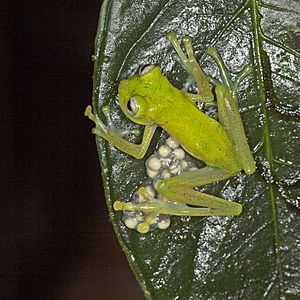Nymphargus griffithsi facts for kids
Quick facts for kids Nymphargus griffithsi |
|
|---|---|
 |
|
| Conservation status | |
| Scientific classification | |
| Synonyms | |
|
The Nymphargus griffithsi is a special kind of frog that belongs to the Centrolenidae family. These frogs are often called "glass frogs" because some of them have skin that you can see through! This particular frog was first described in 1961.
You can find the Nymphargus griffithsi in two countries: Colombia and Ecuador. They live in very specific places, usually in warm, wet montane forests (forests on mountains) and near rivers. These areas are their natural habitats, which means they are the perfect places for them to live and thrive.
Contents
What is a Glass Frog?
Glass frogs are amazing amphibians. They get their name because the skin on their belly is often clear. This means you can sometimes see their insides, like their organs and bones! Not all glass frogs are completely see-through, but many have this cool feature.
Where Do They Live?
Nymphargus griffithsi frogs prefer to live in subtropical or tropical areas. These are places that are warm all year round. They need a lot of moisture, so they are often found in misty mountain forests. Being close to rivers is also important for them, likely for breeding and finding food.
Their Mountain Homes
The "montane forest" part of their habitat means they live in forests on the sides of mountains. These forests are usually very green and wet, with lots of plants and trees. The air is often humid, which is perfect for frogs that need to keep their skin moist.
Why Are They Important?
Every animal plays a role in its ecosystem. Frogs like the Nymphargus griffithsi are part of the food chain. They eat small insects and, in turn, can be food for larger animals. This helps keep the natural world balanced.
Threats to Their Survival
Sadly, the Nymphargus griffithsi frog is facing a big problem: habitat loss. This means that the places where they live are disappearing. Forests are being cut down for farming, building, or other human activities. When their homes are destroyed, these frogs have nowhere to go, which puts their future at risk.
Protecting Their Habitat
It's important to protect the forests and rivers where these frogs live. Conservation efforts help save their homes and ensure that these unique creatures can continue to survive for many years to come. Protecting their habitat also helps countless other plants and animals that share the same environment.
See also
 In Spanish: Rana de Cristal para niños
In Spanish: Rana de Cristal para niños


